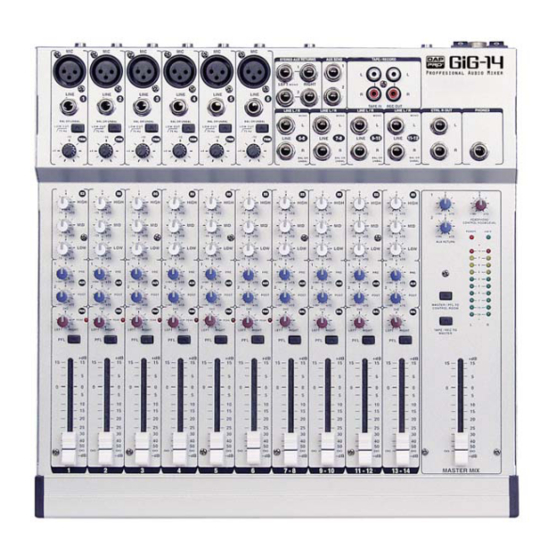DAPAudio Gig 14 사용자 설명서 - 페이지 13
{카테고리_이름} DAPAudio Gig 14에 대한 사용자 설명서을 온라인으로 검색하거나 PDF를 다운로드하세요. DAPAudio Gig 14 18 페이지.

signals should not exceed 0 dB.
4) For Stereo Channels and other stereo line inputs, use the output volume of the source instrument effect
gain adjustment, until transient peaks are regularly hitting + 6db. Continuous signals should not exceed
0 dB.
5) Altering EQ will affect a channel's gain. I f EQ is adjusted at any time, repeat steps 2, 3 or 4.
6) Turn the channel's volume control fully counter-clockwise. Move onto next channel and repeat steps 1
thru 6.
7) Once all channel inputs have been set for level, turn all active channel level controls back to 0 dB. You
are now ready to start mixing.
5. Recording Levels
When recording to digital, it's a good idea to keep the recorder's peak meters below 0 dB. Most (not all esp.
Samplers) read 0 dB with some headroom left. This is because, unlike with analog, the onset of digital
distortion is as sudden as it is horrible. If you really want to take your recording level to the limit (and fully
exploit 16-bit digital's 96 dB dynamic range for example), you'll have to do some calibrating. How to
calibrate? You could run a tone at 0 dB from the mixer and use that as your DAT or ADAT reference. But
your DAT or ADAT may be way under its maximum input limit. Probably a better way to work out just how
hard you can drive your recorder is, to incrementally increase the record level until the onset of digital
distortion. Subtract 5 or 10 dB, and you never exceed that level. Engage "peak hold" on your recorder
before recording, if you want to confirm that you haven't. Peak meters read more-or-less independent of
frequency. You should aim for 0 dB recording level for all signals.
6. Modification
The following modifications require some soldering. Only attempt if you are experienced in using an iron on
PCBs. Otherwise, refer to qualified personnel. After modification the Dap Audio warranty becomes void.
Links should not be threaded into holes on the PCB. They should be soldered to the tinned areas around
the holes, and bowed slightly upwards in between.
Mono Channel Aux Send 2 > pre-fader
All mono channels Aux Sends 2 are post-fader. If you want to convert them, carry out the modification
described below to each mono channel you want to be altered. The right PCB area is indicated by the
yellow printing (see figures below).
1) Switch desk off and disconnect it from the main supply.
2) Cut the "post" track
3) Add in a "pre" link
Repeat for all mono channels you want to be modified.
11
